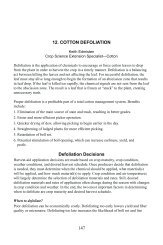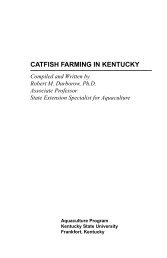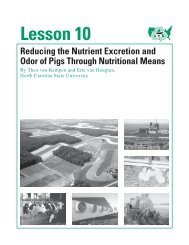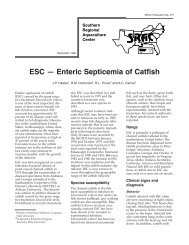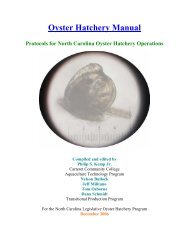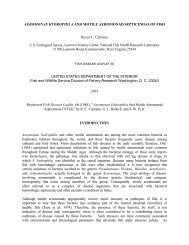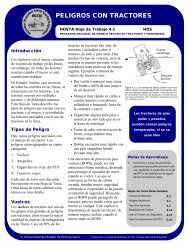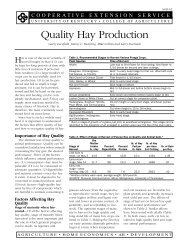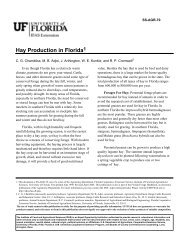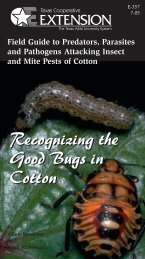Dryland Pastures in Montana and Wyoming - MSU Extension
Dryland Pastures in Montana and Wyoming - MSU Extension
Dryland Pastures in Montana and Wyoming - MSU Extension
You also want an ePaper? Increase the reach of your titles
YUMPU automatically turns print PDFs into web optimized ePapers that Google loves.
<strong>in</strong>g season. Plants also beg<strong>in</strong> growth earlier <strong>in</strong> the spr<strong>in</strong>g <strong>and</strong> produce more tillers<br />
(shoots) per plant when some stubble rema<strong>in</strong>s from the previous year. A prote<strong>in</strong>carotene<br />
supplement is usually needed if livestock graze seeded pastures when<br />
plants are dormant.<br />
Graz<strong>in</strong>g Intensity<br />
Well-managed seeded pastures can usually be stocked at higher rates than adjacent<br />
native rangel<strong>and</strong>. Table 5 presents <strong>in</strong>itial suggested stock<strong>in</strong>g rates for several<br />
grasses <strong>and</strong> crop aftermath. Seeded pastures grazed annually at the same time of<br />
year for only a brief period (i.e., less than three weeks) do not benefit much from<br />
rotational graz<strong>in</strong>g.<br />
Table 5. Stock<strong>in</strong>g rate guidel<strong>in</strong>es for dryl<strong>and</strong> pastures <strong>and</strong> crop aftermath.<br />
Pasture<br />
Crested wheatgrass<br />
Russian wildrye<br />
Pubescent wheatgrass<br />
Precipitation Zone<br />
(<strong>in</strong>ches)<br />
AUM Per Acre Acre Per AUM<br />
10–14 0.67 1.5<br />
15–18 1.00 1.0<br />
10–14 0.50 2.0<br />
15–18 1.00 1.0<br />
13–14 0.75 1.3<br />
15–18 1.25 0.8<br />
Intermediate wheatgrass 14–18 1.50 0.7<br />
Meadow bromegrass 16–18 1.50 0.7<br />
Timothy 16–18 1.25 0.8<br />
Orchardgrass 16–18 1.50 0.7<br />
Gra<strong>in</strong> aftermath<br />
Hay aftermath<br />
10-14<br />
15-18<br />
10-14<br />
15-18<br />
0.20*<br />
0.30*<br />
0.40<br />
0.50<br />
5.0*<br />
3.3*<br />
*Do not graze if <strong>in</strong>sufficient stubble rema<strong>in</strong>s to protect the soil from w<strong>in</strong>d or water erosion.<br />
2.5<br />
2.0<br />
Rotational Graz<strong>in</strong>g<br />
Some dryl<strong>and</strong> seed<strong>in</strong>gs conta<strong>in</strong> plant species that can be used <strong>in</strong> either spr<strong>in</strong>g<br />
or fall (Tables 1-4). These seed<strong>in</strong>gs can benefit from two-pasture or three-pasture<br />
graz<strong>in</strong>g programs. In a two-pasture program, the seed<strong>in</strong>g is separated <strong>in</strong>to two pastures,<br />
with one pasture grazed dur<strong>in</strong>g spr<strong>in</strong>g <strong>and</strong> the other grazed dur<strong>in</strong>g fall (Table<br />
6). The graz<strong>in</strong>g season (spr<strong>in</strong>g or fall) is then rotated between the two pastures annually.<br />
Graz<strong>in</strong>g <strong>in</strong> the fall season pasture should be adjusted to leave about 50 percent<br />
of the st<strong>and</strong><strong>in</strong>g forage for consumption <strong>in</strong> the follow<strong>in</strong>g spr<strong>in</strong>g.<br />
A three-pasture program subdivides the spr<strong>in</strong>g graz<strong>in</strong>g season <strong>in</strong>to two halves.<br />
— 21 —




